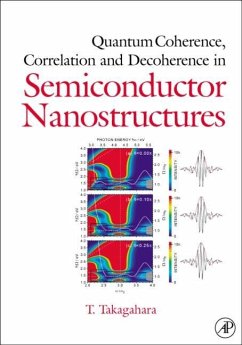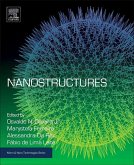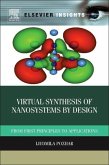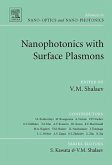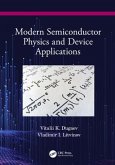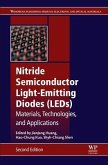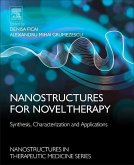Toshihide Takagahara
Quantum Coherence Correlation and Decoherence in Semiconductor Nanostructures
Toshihide Takagahara
Quantum Coherence Correlation and Decoherence in Semiconductor Nanostructures
- Gebundenes Buch
- Merkliste
- Auf die Merkliste
- Bewerten Bewerten
- Teilen
- Produkt teilen
- Produkterinnerung
- Produkterinnerung
Semiconductor nanostructures are attracting a great deal of interest as the most promising device with which to implement quantum information processing and quantum computing. This book surveys the present status of nanofabrication techniques, near field spectroscopy and microscopy to assist the fabricated nanostructures. It will be essential reading for academic and industrial researchers in pure and applied physics, optics, semiconductors and microelectronics.
Andere Kunden interessierten sich auch für
![Nanotechnology and Functional Materials for Engineers Nanotechnology and Functional Materials for Engineers]() Yaser DahmanNanotechnology and Functional Materials for Engineers100,99 €
Yaser DahmanNanotechnology and Functional Materials for Engineers100,99 €![Nanostructures Nanostructures]() Nanostructures107,99 €
Nanostructures107,99 €![Virtual Synthesis of Nanosystems by Design Virtual Synthesis of Nanosystems by Design]() Liudmila PozharVirtual Synthesis of Nanosystems by Design79,99 €
Liudmila PozharVirtual Synthesis of Nanosystems by Design79,99 €![Nanophotonics with Surface Plasmons Nanophotonics with Surface Plasmons]() Vladimir M. Shalaev (Volume ed.)Nanophotonics with Surface Plasmons117,99 €
Vladimir M. Shalaev (Volume ed.)Nanophotonics with Surface Plasmons117,99 €![Modern Semiconductor Physics and Device Applications Modern Semiconductor Physics and Device Applications]() Vitalii DugaevModern Semiconductor Physics and Device Applications51,99 €
Vitalii DugaevModern Semiconductor Physics and Device Applications51,99 €![Nitride Semiconductor Light-Emitting Diodes (Leds) Nitride Semiconductor Light-Emitting Diodes (Leds)]() Jian-Jang HuangNitride Semiconductor Light-Emitting Diodes (Leds)259,99 €
Jian-Jang HuangNitride Semiconductor Light-Emitting Diodes (Leds)259,99 €![Nanostructures for Novel Therapy Nanostructures for Novel Therapy]() Nanostructures for Novel Therapy172,99 €
Nanostructures for Novel Therapy172,99 €-
-
-
Semiconductor nanostructures are attracting a great deal of interest as the most promising device with which to implement quantum information processing and quantum computing. This book surveys the present status of nanofabrication techniques, near field spectroscopy and microscopy to assist the fabricated nanostructures. It will be essential reading for academic and industrial researchers in pure and applied physics, optics, semiconductors and microelectronics.
Produktdetails
- Produktdetails
- Verlag: Academic Press / Elsevier Science & Technology
- Artikelnr. des Verlages: B978-0-12-682225-0.X5000-7
- Seitenzahl: 496
- Erscheinungstermin: 6. Juni 2003
- Englisch
- Abmessung: 27mm x 152mm x 229mm
- Gewicht: 960g
- ISBN-13: 9780126822250
- ISBN-10: 0126822255
- Artikelnr.: 21378661
- Herstellerkennzeichnung
- Libri GmbH
- Europaallee 1
- 36244 Bad Hersfeld
- gpsr@libri.de
- Verlag: Academic Press / Elsevier Science & Technology
- Artikelnr. des Verlages: B978-0-12-682225-0.X5000-7
- Seitenzahl: 496
- Erscheinungstermin: 6. Juni 2003
- Englisch
- Abmessung: 27mm x 152mm x 229mm
- Gewicht: 960g
- ISBN-13: 9780126822250
- ISBN-10: 0126822255
- Artikelnr.: 21378661
- Herstellerkennzeichnung
- Libri GmbH
- Europaallee 1
- 36244 Bad Hersfeld
- gpsr@libri.de
PrefaceList of ContributorsChapter 1 Coherent Nonlinear Pulse Propagation on a Free-Exciton Resonance in a Semiconductor 1.1 Introduction 1.2 Theoretical Background 1.3 Samples and Experimental Techniques 1.4 Results and Discussion Excitation-Induced Suppression of Temporal Polariton Beating Self-Induced Transmission and Multiple Pulse Breakup Phonon-Induced Dephasing of the Excitonic Polarization 1.5 Conclusions Acknowledgments ReferencesChapter 2 Carrier-Wave Rabi Flopping in Semiconductors 2.1 Introduction 2.2 Carrier-Wave Rabi Flopping Experiments Theory 2.3 Conclusions Acknowledgments ReferencesChapter 3 High-Field Effects in Semiconductor Nanostructures 3.1 Introduction 3.2 General Theory 3.3 High-Field Electo-Optics in Quantum Wells and Wires Real Space Theoretical Approach to Electon-Hole Wave Packets Electro-Magneto-Optical Simulations in Quantum Wells Static Franz-Keldysh Effect in Quantum Wires Dynamic Franz-Keldysh Effect in Quantum Wires 3.4 Excitonic Trapping, Ultrafast Population Transfer, and Rabi Flopping Theory of High Optical Field Effects in Quantum Wells Excitonic Trapping and Ultrafast Population Transfer 3.5 Carrier-Wave Rabi Flopping Theory and Computation of Sub-Optical-Carrier Pulse Propagation Breakdown of the Area Theorem in a Two-Level Atom Carrier-Wave Rabi Flopping in Semiconductors 3.6 Conclusions Acknowledgments ReferencesChapter 4 Theory of Resonant Secondary Emission: Rayleigh Scattering versus Luminescence 4.1 Introduction 4.2 Disorder Eigenstates of Excitons 4.3 Exciton Hamiltonian and Density-Matrix Approach 4.4 Exciton Kinetics with Acoustic Phonon Scattering 4.5 Coherent and Incoherent Emission in the Time Domain 4.6 Speckle Measurement and Interferometry 4.7 Frequency-Resolved Secondary Emission 4.8 Signatures of Level Repulsion 4.9 Enhanced Resonant Backscattering 4.10 Spin- and Polarization-Dependent Emission 4.11 Polariton Effects in the Secondary Emission Appendix A: Potential Variance Appendix B: Weak-Memory and Markov Approximation Appendix C: Radiative Rates ReferencesChapter 5 Higher-Order Coulomb Correlation Effects in Semiconductors 5.1 Introduction 5.2 Ultrafast Spectroscopy of Semiconductor Nanostructures as Probes of Coulomb Correlations Overview of the Semiconductor Equations of Motion with Optical Excitation Non-Interacting and Hartree-Fock Approximations Beyond the Coherent SBE: Screening and Scattering Ultrafast Optical Measurement Techniques 5.3 Beyond the Screened HF Approximation - Theoretical Approaches to Many-Body Correlations Biexcitons and Few-Level Theories The Dynamics-Controlled Truncation Scheme The Coherent Limit Interpreting and Solving the Equations of the DCT The Effective Polarization Model Phonons 5.4 Experimental Studies of High-Order Coulomb Correlations The Fully Coherent Regime Contributions from Incoherent Densities Contributions beyond the Four-Particle Level Contributions beyond the x (3) Truncation 5.5 Future Directions ReferencesChapter 6 Electronic and Nuclear Spin in the Optical Spectra of Semiconductor Quantum Dots 6.1 Introduction to Spin in the Optical Spectrum 6.2 Photoluminescence Spectroscopy of Quantum Dots Natural (Interface Fluctuation) QDs Photoluminescence Spectroscopy of Single QDs PL Excitation Spectroscopy of Single QDs 6.3 Exciton Fine-Structure (Spin and Sublevels) Exchange Interaction Long-Range Exchange Interaction Zeeman Interaction Pseudo-Spin Model Relaxation Polarization Including Finite Relaxation Hanle Effect
PrefaceList of ContributorsChapter 1 Coherent Nonlinear Pulse Propagation on a Free-Exciton Resonance in a Semiconductor 1.1 Introduction 1.2 Theoretical Background 1.3 Samples and Experimental Techniques 1.4 Results and Discussion Excitation-Induced Suppression of Temporal Polariton Beating Self-Induced Transmission and Multiple Pulse Breakup Phonon-Induced Dephasing of the Excitonic Polarization 1.5 Conclusions Acknowledgments ReferencesChapter 2 Carrier-Wave Rabi Flopping in Semiconductors 2.1 Introduction 2.2 Carrier-Wave Rabi Flopping Experiments Theory 2.3 Conclusions Acknowledgments ReferencesChapter 3 High-Field Effects in Semiconductor Nanostructures 3.1 Introduction 3.2 General Theory 3.3 High-Field Electo-Optics in Quantum Wells and Wires Real Space Theoretical Approach to Electon-Hole Wave Packets Electro-Magneto-Optical Simulations in Quantum Wells Static Franz-Keldysh Effect in Quantum Wires Dynamic Franz-Keldysh Effect in Quantum Wires 3.4 Excitonic Trapping, Ultrafast Population Transfer, and Rabi Flopping Theory of High Optical Field Effects in Quantum Wells Excitonic Trapping and Ultrafast Population Transfer 3.5 Carrier-Wave Rabi Flopping Theory and Computation of Sub-Optical-Carrier Pulse Propagation Breakdown of the Area Theorem in a Two-Level Atom Carrier-Wave Rabi Flopping in Semiconductors 3.6 Conclusions Acknowledgments ReferencesChapter 4 Theory of Resonant Secondary Emission: Rayleigh Scattering versus Luminescence 4.1 Introduction 4.2 Disorder Eigenstates of Excitons 4.3 Exciton Hamiltonian and Density-Matrix Approach 4.4 Exciton Kinetics with Acoustic Phonon Scattering 4.5 Coherent and Incoherent Emission in the Time Domain 4.6 Speckle Measurement and Interferometry 4.7 Frequency-Resolved Secondary Emission 4.8 Signatures of Level Repulsion 4.9 Enhanced Resonant Backscattering 4.10 Spin- and Polarization-Dependent Emission 4.11 Polariton Effects in the Secondary Emission Appendix A: Potential Variance Appendix B: Weak-Memory and Markov Approximation Appendix C: Radiative Rates ReferencesChapter 5 Higher-Order Coulomb Correlation Effects in Semiconductors 5.1 Introduction 5.2 Ultrafast Spectroscopy of Semiconductor Nanostructures as Probes of Coulomb Correlations Overview of the Semiconductor Equations of Motion with Optical Excitation Non-Interacting and Hartree-Fock Approximations Beyond the Coherent SBE: Screening and Scattering Ultrafast Optical Measurement Techniques 5.3 Beyond the Screened HF Approximation - Theoretical Approaches to Many-Body Correlations Biexcitons and Few-Level Theories The Dynamics-Controlled Truncation Scheme The Coherent Limit Interpreting and Solving the Equations of the DCT The Effective Polarization Model Phonons 5.4 Experimental Studies of High-Order Coulomb Correlations The Fully Coherent Regime Contributions from Incoherent Densities Contributions beyond the Four-Particle Level Contributions beyond the x (3) Truncation 5.5 Future Directions ReferencesChapter 6 Electronic and Nuclear Spin in the Optical Spectra of Semiconductor Quantum Dots 6.1 Introduction to Spin in the Optical Spectrum 6.2 Photoluminescence Spectroscopy of Quantum Dots Natural (Interface Fluctuation) QDs Photoluminescence Spectroscopy of Single QDs PL Excitation Spectroscopy of Single QDs 6.3 Exciton Fine-Structure (Spin and Sublevels) Exchange Interaction Long-Range Exchange Interaction Zeeman Interaction Pseudo-Spin Model Relaxation Polarization Including Finite Relaxation Hanle Effect

